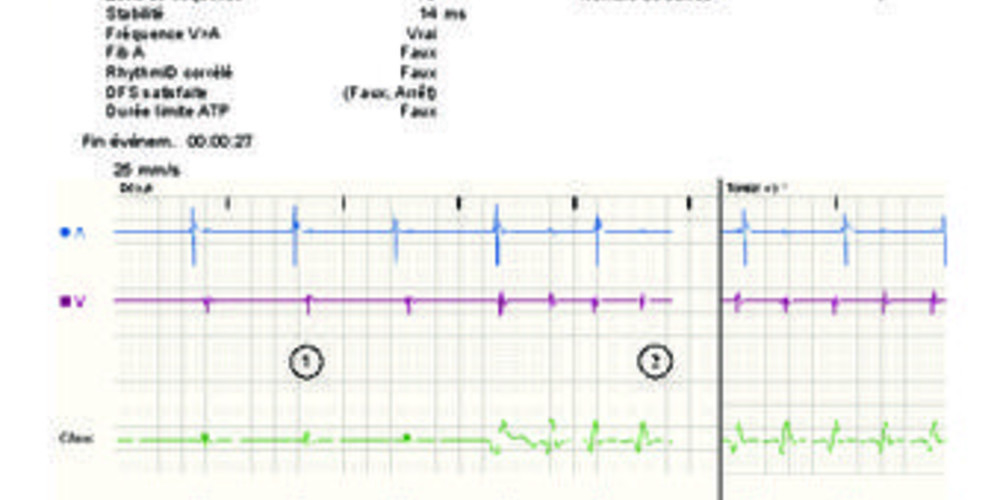Successful burst for repetitive episodes of VT
Tracing
Manufacturer Boston Scientific
Device ICD
Field Therapy
N° 7
Patient
This 39-year-old woman presenting with ischemic cardiomyopathy and old myocardial infarction received a Boston Science Teligen dual chamber defibrillator for secondary prevention of VT at rates between 130 and 140 bpm. She suffered an electrical storm with multiples episodes of VT treated with ≥1 sequence(s) of ATP.

Graph and trace
Summary 1
Episode of VT (discrimination V>A) at 140 bpm, treated with a single sequence of ATP.
Tracing 1
- sinus rhythm (AS-VS);
- tachycardia detected in the VT zone, starting suddenly, stable, though with a clear change in the morphology compared with sinus rhythm, particularly visible on the high-voltage channel. Atrioventricular dissociation (V>A) confirming the ventricular origin of the tachycardia;
- 8 out of 10 criterion fulfilled for the VT zone (V-Epsd);
- 10-sec Duration, throughout which the 6 out of 10 criterion remained fulfilled despite occasional VS classified cycles (sustained VT: V-Detect);
- burst of 10 complexes of ATP at fixed rate; RV pacing;
- successful burst and termination of the arrhythmia.
Summary 2
Second episode on the same day, requiring 2 bursts of ATP.
Tracing 2
- VT already on going (AV dissociation), though the ventricular rate was below the lower limit of the VT zone. The ventricular events were, therefore, labeled VS;
- slight acceleration of the tachyarrhythmia, entering the VT zone (VT). The tachycardia remained at the limit of the VT zone. Alternating VS and VT cycles;
- 8 out of 10 criterion fulfilled for the VT zone;
- 6 out of 10 criterion no longer fulfilled;
- 8 out of 10 criterion again fulfilled;
- the 6 out of 10 criterion remained fulfilled for the entire Duration;
- first burst of 10 complexes;
- after the burst, beginning of the redetection phase;
- 8 out of 10 criterion fulfilled;
- end of the Duration of redetection for the VT zone (programmed at 1 sec); no therapy delivered since the cycle was classified VS (V-Dur marker, since the 6 out of 10 criterion remained fulfilled);
- V-Detect marker on the next short cycle;
- second burst of 12 cycles at the same rate than previously;
- successful burst and end of arrhythmia.
Summary 3
Further similar episode, on the same day, requiring 6 then 3 bursts of ATP.
Tracing 3
- same VT as during earlier episodes;
- first burst of 10 cycles of ATP;
- unsuccessful burst;
- second burst of 12 ATP cycles; no change in the rate stimulation compared with the previous burst, though 2 stimuli were added;
- unsuccessful burst;
- third burst of 14 ATP cycles; 2 pacing stimuli were added compared with the previous burst;
- unsuccessful burst;
- fourth burst of 14 ATP cycles;
- unsuccessful burst;
- fifth burst of 14 ATP cycles;
- unsuccessful burst;
- sixth and last burst of 14 ATP cycles;
- unsuccessful burst;
- first ramp of 10 ATP cycles with a 10-ms decrement; the coupling between the first paced cycle and the last sensed ventricular event is the same as the coupling between the first 2 stimuli; thereafter, the coupling between the stimuli decreases by 10 ms;
- unsuccessful ramp;
- second ramp of 12 ATP cycles with 10-ms decrement; the shortest cycle (245 ms) is, therefore, 20 ms shorter than that of the previous ramp;
- unsuccessful ramp;
- third ramp of 14 complexes with 10-ms decrement; the shortest coupling interval (220 ms) is the shortest programmed paced cycle;
- successful ramp and end of the episode.
Other articles that may be of interest to you






This tracing shows, once again, the value of ATP as a means of sparing the batteries of the device and preserving the patient’s quality of life. This patient had developed multiples episodes of VT that were successfully treated with a single or several pacing sequences. A first series of 6 bursts was programmed, followed by a series of ramps. The latter is not a systematic choice in this range of rates, given the risk of acceleration to a rapid polymorphic tachycardia by the more aggressive ATP. In this patient, approximately 70% of the bursts of ATP were successful, while the ramps terminated the remaining 30% of attempts, avoiding thereby the delivery of electrical shocks.